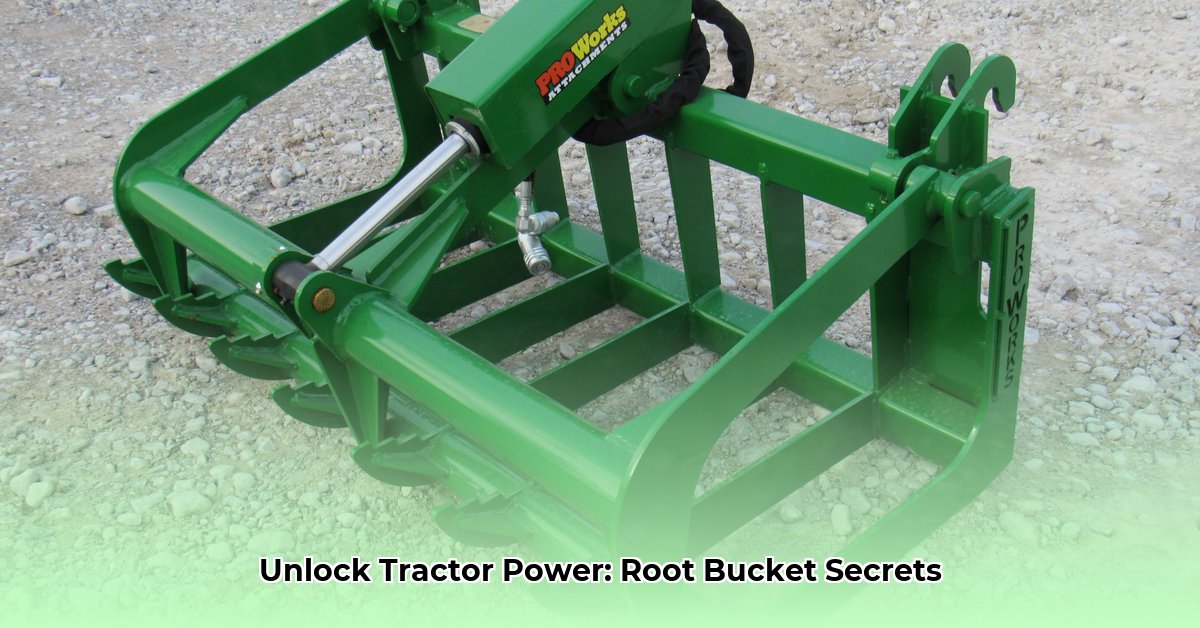
Understanding Root Buckets for Tractors
Root buckets are specialized tractor attachments designed for efficient and gentle harvesting of root vegetables like potatoes, carrots, and beets. Unlike standard shovels or buckets, root buckets feature specially designed tines (small, digging prongs) that minimize crop damage during harvesting. This results in less bruising and higher-quality produce. The size and design variations available allow farmers to choose a bucket perfectly suited to their tractor and the specific crops they cultivate. For more on tractor attachments, see this helpful guide: tractor attachments.
Choosing the Right Root Bucket: A Detailed Analysis
Selecting the correct root bucket hinges on several key factors. First, assess your tractor's hydraulic system capacity. The bucket's weight-lifting capability shouldn't exceed your tractor's hydraulic power. Overloading can strain the hydraulics, potentially leading to damage or malfunction. Secondly, consider the type of root vegetables you'll be harvesting. Delicate root crops like carrots require buckets with gentler tines to avoid excessive damage. Robust root vegetables like parsnips might benefit from sturdier, more aggressive tines. Finally, the scale of your operation influences the ideal bucket size. Small farms might suffice with a compact bucket, while large commercial operations would require larger, heavier-duty models. Don't underestimate the importance of matching the bucket's capacity to your farming operation's demands. What size root bucket do you think would be ideal for your needs?
Key Considerations When Selecting a Root Bucket:
- Tractor Hydraulic Capacity: Ensure the bucket's weight capacity aligns with your tractor's hydraulic power.
- Crop Type: Choose tines suited to the delicacy of your root vegetables (e.g., gentle tines for carrots, sturdier tines for parsnips).
- Scale of Operation: Select a bucket size appropriate for your farm's size and production volume.
Attaching and Detaching Your Root Bucket Safely
Safe and efficient attachment/detachment of a root bucket is paramount. Follow these steps precisely:
Safety First: Always ensure the tractor is securely parked, the engine is off, and the PTO (power take-off) is disengaged before beginning any attachment or detachment procedures. Never compromise safety.
Hydraulic Connections: Carefully connect the hydraulic hoses to the root bucket, ensuring a secure and leak-free connection. Loose or damaged hoses pose a significant safety hazard and can lead to hydraulic fluid leaks.
Three-Point Hitch Attachment: Securely attach the bucket to the tractor's three-point hitch, using the appropriate pins and locking mechanisms. Double check all connections before proceeding—a secure connection prevents accidents and damage.
Functional Test: Before commencing work, gently raise and lower the bucket to test its functionality and confirm all connections in the hydraulics and three point hitch are working flawlessly.
Safe Disconnection: When detaching, reverse these steps meticulously, ensuring all hydraulic connections are safely disconnected before operating the tractor.
Maintaining Optimal Performance: Root Bucket Care and Maintenance
Regular maintenance is crucial to prolong the lifespan and efficiency of your root bucket. The following are recommended practices:
Post-Use Cleaning: Thoroughly clean the bucket after each use to remove soil, debris, and crop residues. This helps prevent rust and corrosion.
Thorough Inspection: Carefully inspect the tines, bucket body, and hydraulic connections for signs of damage or wear. Address any issues promptly to prevent further damage and ensure efficient operation.
Regular Lubrication: Lubricate all moving parts according to the manufacturer's recommendations to minimize friction.
Proper Storage: Store the bucket in a dry location to prevent rust and corrosion.
Prioritizing Safety When Using a Root Bucket
Safe operation is paramount. Always follow these safety guidelines:
- Proper Training: Only operate the bucket after receiving proper training and understanding all safety procedures.
- Protective Gear: Wear safety glasses, gloves, and sturdy, closed-toe boots at all times during operation.
- Safe Operating Area: Avoid operating near people, animals, or obstacles. Keep children and pets a significant distance from the working area.
- Manufacturer's Instructions: Adhere to the manufacturer's safety guidelines and instructions meticulously.
Is a Root Bucket the Right Investment for You?
Investing in a root bucket involves weighing its benefits against potential drawbacks.
| Advantages | Disadvantages |
|---|---|
| Increased harvesting efficiency | Requires a tractor with sufficient hydraulic power |
| Reduced labor costs and back strain | Higher initial purchase cost |
| Minimized crop damage, improved yields | Needs regular maintenance and occasional repairs |
| Handles large volumes of produce quickly | Potential for cumbersome attachment/detachment |
A root bucket is a worthwhile investment for those who regularly harvest root crops, particularly on a large scale. Carefully consider your farming operations and needs to determine the ideal solution for your unique circumstances.